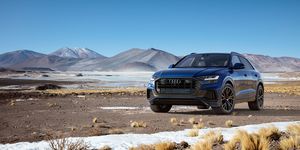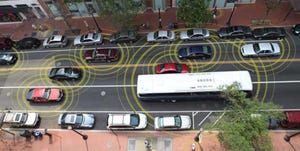- Audi has had vehicle-to-infrastructure (V2X) features in its cars since 2016, and now its Q8 SUV will use them in a Virginia pilot program.
- The Virginia Tech Transportation Institute will build the software needed for deployment, which could add an additional layer of safety for road crews by warning drivers early of their presence.
- Audi notes that the Q8 equipped with this tech won’t be available to the public yet; it’s a testing program only for now.
Audi has a history of outfitting its vehicles with the technology needed to interact with the infrastructure. In 2016, it showed off its traffic signal countdown feature, Traffic Light Information (TLI), which displays just how long you have before the signal turns green. It currently works with the infrastructure of Las Vegas and Washington, D.C. Now the automaker is moving on to the next level: its system can warn drivers when they’re about to encounter construction.
Traffic Light Information system as tested in Washington, D.C.
In partnership with the Virginia Department of Transportation and Qualcomm, the automaker is now working toward the next iteration of vehicle-to-infrastructure communication known as Cellular Vehicle to Everything (C-V2X) using the Q8. Audi tells C/D that this is a test program only, and the Q8 with this technology won’t be available to the public just yet.
Essentially, the roads will have a wireless network. It will be able to send messages to vehicles that support the protocol. The Audi Q8 (and eventually other vehicles) will send and receive information from the network and share it with the driver. This is possible thanks to Qualcomm’s latest chipset for vehicles, which supports the 5.9-Ghz band—popularly known as 5G—and the Virginia Tech Transportation Institute (VTTI), which is building the network infrastructure.
In addition to the traffic-light countdown feature, beginning in the third quarter of 2020 select Virginia roadways will also warn drivers over the network when they approach construction zones. In this scenario, as an Audi Q8 nears a work zone, a series of gradual alerts will make the driver aware it’s coming up. This could be an additional layer of safety for workers and give drivers the option to take another route before they see the orange cones.
Eventually, the idea is to use the network for a range of purposes: to warn drivers of school buses, give motorists a heads up about road conditions created by traffic and weather, and warn drivers that an emergency vehicle is coming up behind them and to move aside. Plus it could potentially be used to guide drivers around upcoming bottlenecks more quickly than apps such as Google and Waze.
The 5.9-GHz band, a Dedicated Short Range Communications (DSRC) standard that’s being deployed by the Virginia DOT, has been set aside for vehicle use since 1999. In November 2019, the FCC moved to quicken the adoption by means of proposed new rules to split up the band. The upper 30 megahertz would be used for “transportation and vehicle safety-related communications,” and the lower 45 megahertz would be used for things like superfast broadband. The benefit of the network is that it’s very quick with low latency. When dealing with vehicles, the quicker the network the better, and because the band is protected from other uses, there’s a lower chance that there will be interference.
There’s also the autonomous-vehicle use case that could guide and inform robotaxis and self-driving shipping vehicles. Of course, like autonomous cars, that’s far off into the future.
Source: Motor - aranddriver.com





